Distribution and Influencing Factors of Metals in Surface Soil from the Yellow River Delta, China
Abstract
:1. Introduction
2. Materials and Methods
2.1. Site Description
2.2. Sampling and Analysis
2.3. Sediment Quality Guidelines (SQGs)
2.4. Enrichment Factor Analysis
2.5. Nemerow Pollution Index Analysis
2.6. Data Analysis
3. Results
3.1. Physicochemical Property of Soil
3.1.1. Yellow River Delta
3.1.2. Under Different Vegetation Types
3.2. Metal Distribution in Soil
3.2.1. Metal Concentration in the Yellow River Delta
3.2.2. Metal Concentrations under Different Vegetation Types
3.3. Risk of the Metals
3.4. Correlation Analysis
4. Discussion
4.1. Effect of pH and Salinity
4.2. Effect of Particle Size
4.3. Effect of Vegetation Types
5. Conclusions
Author Contributions
Funding
Institutional Review Board Statement
Informed Consent Statement
Data Availability Statement
Acknowledgments
Conflicts of Interest
References
- Fatoba, P.O.; Ogunkunle, C.O.; Folarin, O.O.; Oladele, F.A. Heavy metal pollution and ecological geochemistry of soil impacted by activities of oil industry in the Niger Delta, Nigeria. Environ. Earth Sci. 2016, 75, 1–9. [Google Scholar] [CrossRef]
- Yan, X.; Liu, M.; Zhong, J.; Guo, J.; Wu, W. How human activities affect heavy metal contamination of soil and sediment in a long-term reclaimed area of the Liaohe River Delta, North China. Sustainability 2018, 10, 338. [Google Scholar] [CrossRef] [Green Version]
- Lu, Q.; Bai, J.; Zhang, G.; Wu, J. Effects of coastal reclamation history on heavy metals in different types of wetland soils in the Pearl River Delta: Levels, sources and ecological risks. J. Clean. Prod. 2020, 272, 122668. [Google Scholar] [CrossRef]
- Zhang, G.; Bai, J.; Zhao, Q.; Lu, Q.; Jia, J.; Wen, X. Heavy metals in wetland soils along a wetland-forming chronosequence in the Yellow River Delta of China: Levels, sources and toxic risks. Ecol. Indic. 2016, 69, 331–339. [Google Scholar] [CrossRef] [Green Version]
- Miranda, L.S.; Wijesiri, B.; Ayoko, G.A.; Egodawatta, P.; Goonetilleke, A. Water-sediment interactions and mobility of heavy metals in aquatic environments. Water Res. 2021, 202, 117386. [Google Scholar] [CrossRef] [PubMed]
- Jiao, W.; Ouyang, W.; Hao, F.; Liu, B.; Wang, F. Geochemical variability of heavy metals in soil after land use conversions in Northeast China and its environmental applications. Environ. Sci. Processes Impacts 2014, 16, 924–931. [Google Scholar] [CrossRef]
- Zhang, Y.; Zhang, X.; Bi, Z.; Yu, Y.; Shi, P.; Ren, L.; Shan, Z. The impact of land use changes and erosion process on heavy metal distribution in the hilly area of the Loess Plateau, China. Sci. Total Environ. 2020, 718, 137305. [Google Scholar] [CrossRef] [PubMed]
- Düring, R.; Hoss, T.; Gäth, S. Sorption and bioavailability of heavy metals in long-term differently tilled soils amended with organic wastes. Sci. Total Environ. 2003, 313, 227–234. [Google Scholar] [CrossRef]
- Romero-Freire, A.; Sierra-Aragón, M.; Ortiz-Bernad, I.; Martín-Peinado, F.J. Toxicity of arsenic in relation to soil properties: Implications to regulatory purposes. J. Soil. Sediments 2014, 14, 968–979. [Google Scholar] [CrossRef]
- Yao, X.; Xiao, R.; Ma, Z.; Xie, Y.; Zhang, M.; Yu, F. Distribution and contamination assessment of heavy metals in soils from tidal flat, oil exploitation zone and restored wetland in the Yellow River Estuary. Wetlands 2016, 36, 153–165. [Google Scholar] [CrossRef]
- Huang, B.; Yuan, Z.; Li, D.; Zheng, M.; Nie, X.; Liao, Y. Effects of soil particle size on the adsorption, distribution, and migration behaviors of heavy metal (loid) s in soil: A review. Environ. Sci. Processes Impacts 2020, 22, 1596–1615. [Google Scholar] [CrossRef]
- De Souza Machado, A.A.; Spencer, K.; Kloas, W.; Toffolon, M.; Zarfl, C. Metal fate and effects in estuaries: A review and conceptual model for better understanding of toxicity. Sci. Total Environ. 2016, 541, 268–281. [Google Scholar] [CrossRef] [PubMed]
- Li, Y.; Zhang, H.; Chen, X.; Tu, C.; Luo, Y.; Christie, P. Distribution of heavy metals in soils of the Yellow River Delta: Concentrations in different soil horizons and source identification. J. Soil Sediments 2014, 14, 1158–1168. [Google Scholar] [CrossRef]
- Xiao, R.; Zhang, M.; Yao, X.; Ma, Z.; Yu, F.; Bai, J. Heavy metal distribution in different soil aggregate size classes from restored brackish marsh, oil exploitation zone, and tidal mud flat of the yellow river delta. J. Soil. Sediments 2016, 16, 821–830. [Google Scholar] [CrossRef]
- State Oceanic Administration of China. Ocean Environmental Quality Communique of China in 2012. 2013. Available online: http://www.coi.gov.cn/gongbao/huanjing/201304/t20130401_26428.html (accessed on 1 January 2022). (In Chinese)
- Sun, Z.; Mou, X.; Tong, C.; Wang, C.; Xie, Z.; Song, H.; Sun, W.; Lv, Y. Spatial variations and bioaccumulation of heavy metals in intertidal zone of the Yellow River estuary, China. Catena 2015, 126, 43–52. [Google Scholar] [CrossRef]
- Liu, Q.; Liu, G.; Huang, C.; Li, H. Soil physicochemical properties associated with quasi-circular vegetation patches in the Yellow River Delta, China. Geoderma 2019, 337, 202–214. [Google Scholar] [CrossRef]
- Cui, B.; Yang, Q.; Zhang, K.; Zhao, X.; You, Z. Responses of saltcedar (Tamarix chinensis) to water table depth and soil salinity in the Yellow River Delta, China. Plant Ecol. 2010, 209, 279–290. [Google Scholar] [CrossRef]
- Zhao, Q.; Bai, J.; Wang, X.; Zhang, W.; Huang, Y.; Wang, L.; Gao, Y. Soil organic carbon content and stock in wetlands with different hydrologic conditions in the Yellow River Delta, China. Ecohydrol. Hydrobiol. 2020, 20, 537–547. [Google Scholar] [CrossRef]
- Ministry of Agriculture. Soil Testing. (NY/T 1121.16-2006) 2006. Available online: http://www.moa.gov.cn/nybgb/2006/dbq/201806/t20180616_6152330.htm (accessed on 1 January 2022). (In Chinese)
- Ministry of Ecological Environment. Soil Environmental Quality. (GB15618-2018) 2018. Available online: http://www.mee.gov.cn/ywgz/fgbz/bz/bzwb/trhj/201807/t20180703_446029.shtml (accessed on 1 January 2022). (In Chinese)
- Long, E.R.; Macdonald, D.D.; Smith, S.L.; Calder, F.D. Incidence of adverse biological effects within ranges of chemical concentrations in marine and estuarine sediments. Environ. Manag. 1995, 19, 81–97. [Google Scholar] [CrossRef]
- Macdonald, D.D.; Carr, R.S.; Calder, F.D.; Long, E.R.; Ingersoll, C.G. Development and evaluation of sediment quality guidelines for Florida coastal waters. Ecotoxicology 1996, 5, 253–278. [Google Scholar] [CrossRef] [PubMed]
- MacDonald, D.D.; Ingersoll, C.G.; Berger, T.A. Development and Evaluation of Consensus-Based Sediment Quality Guidelines for Freshwater Ecosystems. Arch. Environ. Contam. Toxicol. 2000, 39, 20–31. [Google Scholar] [CrossRef]
- Chester, R.; Stoner, J.H. Pb in particulates from the lower atmosphere of the eastern Atlantic. Nature 1973, 245, 27–28. [Google Scholar] [CrossRef]
- Zoller, W.H.; Gladney, E.S.; Duce, R.A. Atmospheric concentrations and sources of trace metals at the South Pole. Science 1974, 183, 198–200. [Google Scholar] [CrossRef] [PubMed]
- China National Environmental Monitoring Center. The Background Concentrations of Soil Elements of China; China Environmental Science Press: Beijing, China, 1990. (In Chinese) [Google Scholar]
- Li, Y.; Yu, Y.; Yang, Z.; Shen, Z.; Wang, X.; Cai, Y. A comparison of metal distribution in surface dust and soil among super city, town, and rural area. Environ. Sci. Pollut. R. 2016, 23, 7849–7860. [Google Scholar] [CrossRef] [PubMed]
- Githaiga, K.B.; Njuguna, S.M.; Makokha, V.A.; Wang, J.; Gituru, R.W.; Yan, X. Assessment of Cu, Zn, Mn, and Fe enrichment in Mt. Kenya soils: Evidence for atmospheric deposition and contamination. Environ. Monit. Assess. 2020, 192, 1–10. [Google Scholar] [CrossRef]
- Sutherland, R.A. Bed sediment-associated trace metals in an urban stream, Oahu, Hawaii. Environ. Geol. 2000, 39, 611–627. [Google Scholar] [CrossRef]
- Yang, Z.; Lu, W.; Long, Y.; Bao, X.; Yang, Q. Assessment of heavy metals contamination in urban topsoil from Changchun City, China. J. Geochem. Explor. 2011, 108, 27–38. [Google Scholar] [CrossRef]
- Kowalska, J.; Mazurek, R.; Gąsiorek, M.; Setlak, M.; Zaleski, T.; Waroszewski, J. Soil pollution indices conditioned by medieval metallurgical activity—A case study from Krakow (Poland). Environ. Pollut. 2016, 218, 1023–1036. [Google Scholar] [CrossRef]
- Memoli, V.; Esposito, F.; Panico, S.C.; De Marco, A.; Barile, R.; Maisto, G. Evaluation of tourism impact on soil metal accumulation through single and integrated indices. Sci. Total Environ. 2019, 682, 685–691. [Google Scholar] [CrossRef]
- Huang, Q.; Tang, S.; Huang, X.; Zhang, F.; Yi, Q.; Li, P.; Fu, H. Influence of rice cultivation on the abundance and fractionation of Fe, Mn, Zn, Cu, and Al in acid sulfate paddy soils in the Pearl River Delta. Chem. Geol. 2017, 448, 93–99. [Google Scholar] [CrossRef]
- Xiao, S.; Luo, M.; Liu, Y.; Bai, J.; Yang, Y.; Zhai, Z.; Huang, J. Rhizosphere effect and its associated soil-microbe interactions drive iron fraction dynamics in tidal wetland soils. Sci. Total Environ. 2021, 756, 144056. [Google Scholar] [CrossRef]
- Zhang, Y.; Chen, J.; Wang, L.; Zhao, Y.; Ou, P.; Shi, W. Establishing a health risk assessment for metal speciation in soil—A case study in an industrial area in China. Ecotox. Environ. Saf. 2018, 166, 488–497. [Google Scholar] [CrossRef]
- Król, A.; Mizerna, K.; Bożym, M. An assessment of pH-dependent release and mobility of heavy metals from metallurgical slag. J. Hazard. Mater. 2020, 384, 121502. [Google Scholar] [CrossRef]
- Yan, J.; Fischel, M.; Chen, H.; Siebecker, M.G.; Wang, P.; Zhao, F.; Sparks, D.L. Cadmium speciation and release kinetics in a paddy soil as affected by soil amendments and flooding-draining cycle. Environ. Pollut. 2021, 268, 115944. [Google Scholar] [CrossRef]
- Shen, B.; Wang, X.; Zhang, Y.; Zhang, M.; Wang, K.; Xie, P.; Ji, H. The optimum pH and Eh for simultaneously minimizing bioavailable cadmium and arsenic contents in soils under the organic fertilizer application. Sci. Total Environ. 2020, 711, 135229. [Google Scholar] [CrossRef]
- Bai, J.; Jia, J.; Zhang, G.; Zhao, Q.; Lu, Q.; Cui, B.; Liu, X. Spatial and temporal dynamics of heavy metal pollution and source identification in sediment cores from the short-term flooding riparian wetlands in a Chinese delta. Environ. Pollut. 2016, 219, 379–388. [Google Scholar] [CrossRef] [PubMed] [Green Version]
- Feng, C.; Guo, X.; Yin, S.; Tian, C.; Li, Y.; Shen, Z. Heavy metal partitioning of suspended particulate matter–water and sediment–water in the Yangtze Estuary. Chemosphere 2017, 185, 717–725. [Google Scholar] [CrossRef]
- Du Laing, G.; De Vos, R.; Vandecasteele, B.; Lesage, E.; Tack, F.M.G.; Verloo, M.G. Effect of salinity on heavy metal mobility and availability in intertidal sediments of the Scheldt estuary. Estuar. Coast. Shelf Sci. 2008, 77, 589–602. [Google Scholar] [CrossRef]
- Zhao, S.; Feng, C.; Wang, D.; Liu, Y.; Shen, Z. Salinity increases the mobility of Cd, Cu, Mn, and Pb in the sediments of Yangtze Estuary: Relative role of sediments’ properties and metal speciation. Chemosphere 2013, 91, 977–984. [Google Scholar] [CrossRef]
- Liu, J.; Diao, Z.; Xu, X.; Xie, Q. Effects of dissolved oxygen, salinity, nitrogen and phosphorus on the release of heavy metals from coastal sediments. Sci. Total Environ. 2019, 666, 894–901. [Google Scholar] [CrossRef]
- Lutts, S.; Qin, P.; Han, R. Salinity influences biosorption of heavy metals by the roots of the halophyte plant species Kosteletzkya pentacarpos. Ecol. Eng. 2016, 95, 682–689. [Google Scholar] [CrossRef]
- Zhang, Q.; Zhang, F.; Huang, C. Heavy metal distribution in particle size fractions of floodplain soils from Dongchuan, Yunnan Province, Southwest China. Environ. Monit. Assess. 2021, 193, 1–17. [Google Scholar] [CrossRef] [PubMed]
- Park, H.J.; Park, H.J.; Yang, H.I.; Park, S.I.; Lim, S.S.; Kwak, J.H.; Lee, G.T.; Lee, S.M.; Park, M.; Choi, W.J. Sorption of Pb in chemical and particle-size fractions of soils with different physico-chemical properties. J. Soil Sediments 2019, 19, 310–321. [Google Scholar] [CrossRef]
- Kang, X.; Song, J.; Yuan, H.; Duan, L.; Li, X.; Li, N.; Liang, X.; Qu, B. Speciation of heavy metals in different grain sizes of Jiaozhou Bay sediments: Bioavailability, ecological risk assessment and source analysis on a centennial timescale. Ecotox. Environ. Saf. 2017, 143, 296–306. [Google Scholar] [CrossRef]
- Acosta, J.A.; Cano, A.F.; Arocena, J.M.; Debela, F.; Martínez-Martínez, S. Distribution of metals in soil particle size fractions and its implication to risk assessment of playgrounds in Murcia City (Spain). Geoderma 2009, 149, 101–109. [Google Scholar] [CrossRef]
- Zhao, M.; Wang, E.; Xia, P.; Feng, A.; Chi, Y.; Sun, Y. Distribution and pollution assessment of heavy metals in the intertidal zone environments of typical sea areas in China. Mar. Pollut. Bull. 2019, 138, 397–406. [Google Scholar] [CrossRef]
- Uddin, M.K. A review on the adsorption of heavy metals by clay minerals, with special focus on the past decade. Chem. Eng. J. 2017, 308, 438–462. [Google Scholar] [CrossRef]
- Schjønning, P.; McBride, R.A.; Keller, T.; Obour, P.B. Predicting soil particle density from clay and soil organic matter contents. Geoderma 2017, 286, 83–87. [Google Scholar] [CrossRef]
- Zhang, J.; Yang, B.; Chen, T.; Sun, X.; Chen, C. Metal speciation and pollution assessment of Cd and Pb in intertidal sediments of Donghai Island, China. Reg. Stud. Mar. Sci. 2016, 6, 37–48. [Google Scholar] [CrossRef]
- Yu, J.; Lv, X.; Bin, M.; Wu, H.; Du, S.; Zhou, M.; Yang, Y.; Han, G. Fractal features of soil particle size distribution in newly formed wetlands in the Yellow River Delta. Sci. Rep. 2015, 5, 10540. [Google Scholar] [CrossRef] [Green Version]
- Yang, J.; Tam, N.F.; Ye, Z. Root porosity, radial oxygen loss and iron plaque on roots of wetland plants in relation to zinc tolerance and accumulation. Plant Soil. 2014, 374, 815–828. [Google Scholar] [CrossRef]
- Khan, N.; Seshadri, B.; Bolan, N.; Saint, C.P.; Kirkham, M.B.; Chowdhury, S.; Yamaguchi, N.; Lee, D.Y.; Li, G.; Kunhikrishnan, A.; et al. Root Iron Plaque on Wetland Plants as a Dynamic Pool of Nutrients and Contaminants. Adv. Agron. 2016, 138, 1–96. [Google Scholar]
- Zhang, S.; Bai, J.; Wang, W.; Huang, L.; Zhang, G.; Wang, D. Heavy metal contents and transfer capacities of Phragmites australis and Suaeda salsa in the Yellow River Delta, China. Phys. Chem. Earth Parts A B C 2018, 104, 3–8. [Google Scholar]
- Song, H.; An, J.; Liu, Q.; Jin, X.; Wu, Y.; Wu, X.; Yan, Y. Cd absorption characteristics of Suaeda salsa under different sediment burial and exogenous Cd input conditions in the Yellow River estuary, China. Environ. Sci. Pollut. R. 2021, 28, 62368–62377. [Google Scholar] [CrossRef]
- Song, H.; Sun, Z. Temporal variations and bioaccumulation of heavy metals in different Suaeda salsa marshes of the Yellow River estuary, China. Environ. Sci. Pollut. R. 2014, 21, 14174–14187. [Google Scholar]
- Cheng, Y.; Yang, L.; Cao, Z.; Ci, E.; Yin, S. Chronosequential changes of selected pedogenic properties in paddy soils as compared with non-paddy soils. Geoderma 2009, 151, 31–41. [Google Scholar]
- Liu, S.; Hou, X.; Yang, M.; Cheng, F.; Coxixo, A.; Wu, X.; Zhang, Y. Factors driving the relationships between vegetation and soil properties in the Yellow River Delta, China. Catena 2018, 165, 279–285. [Google Scholar]
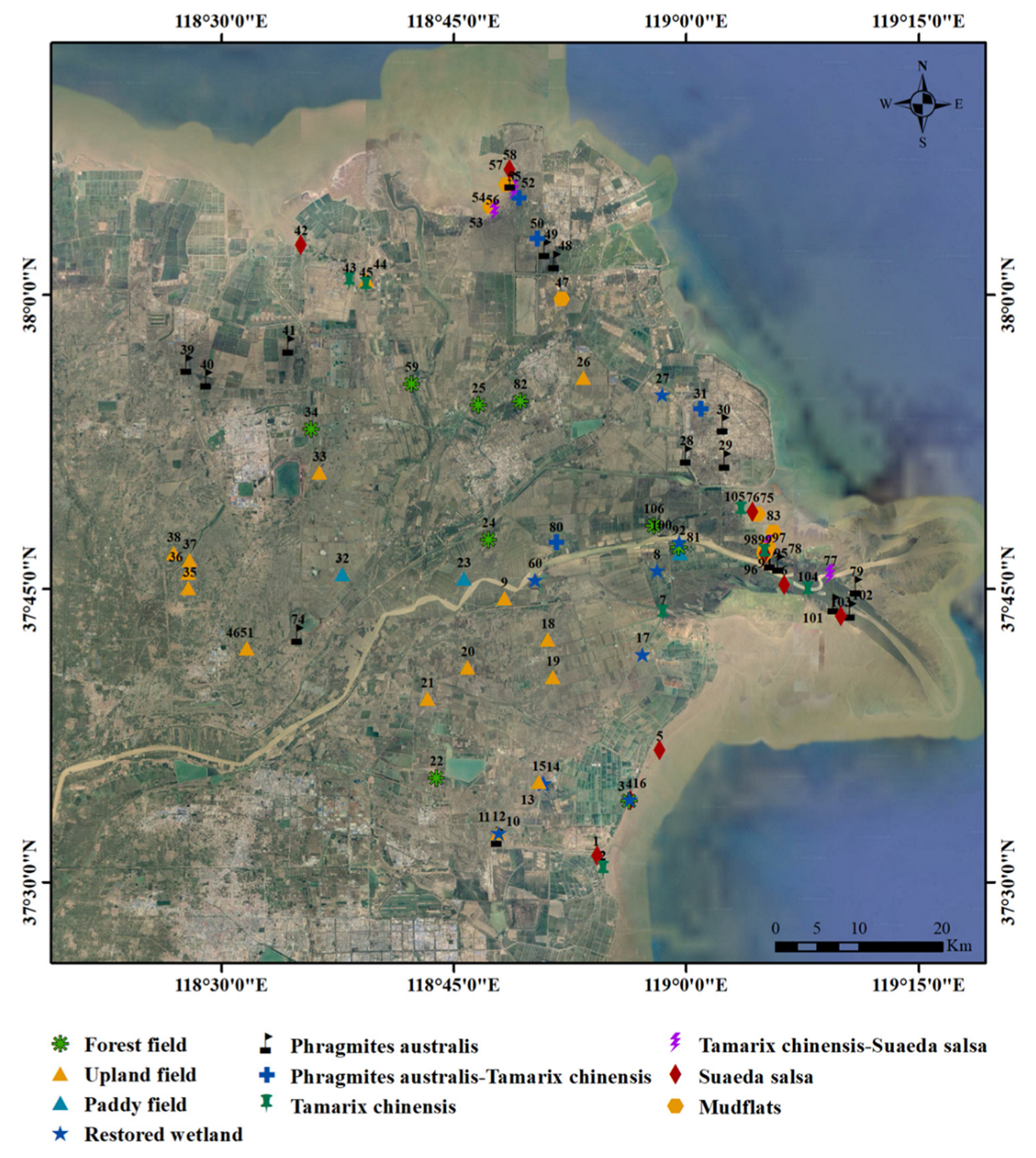

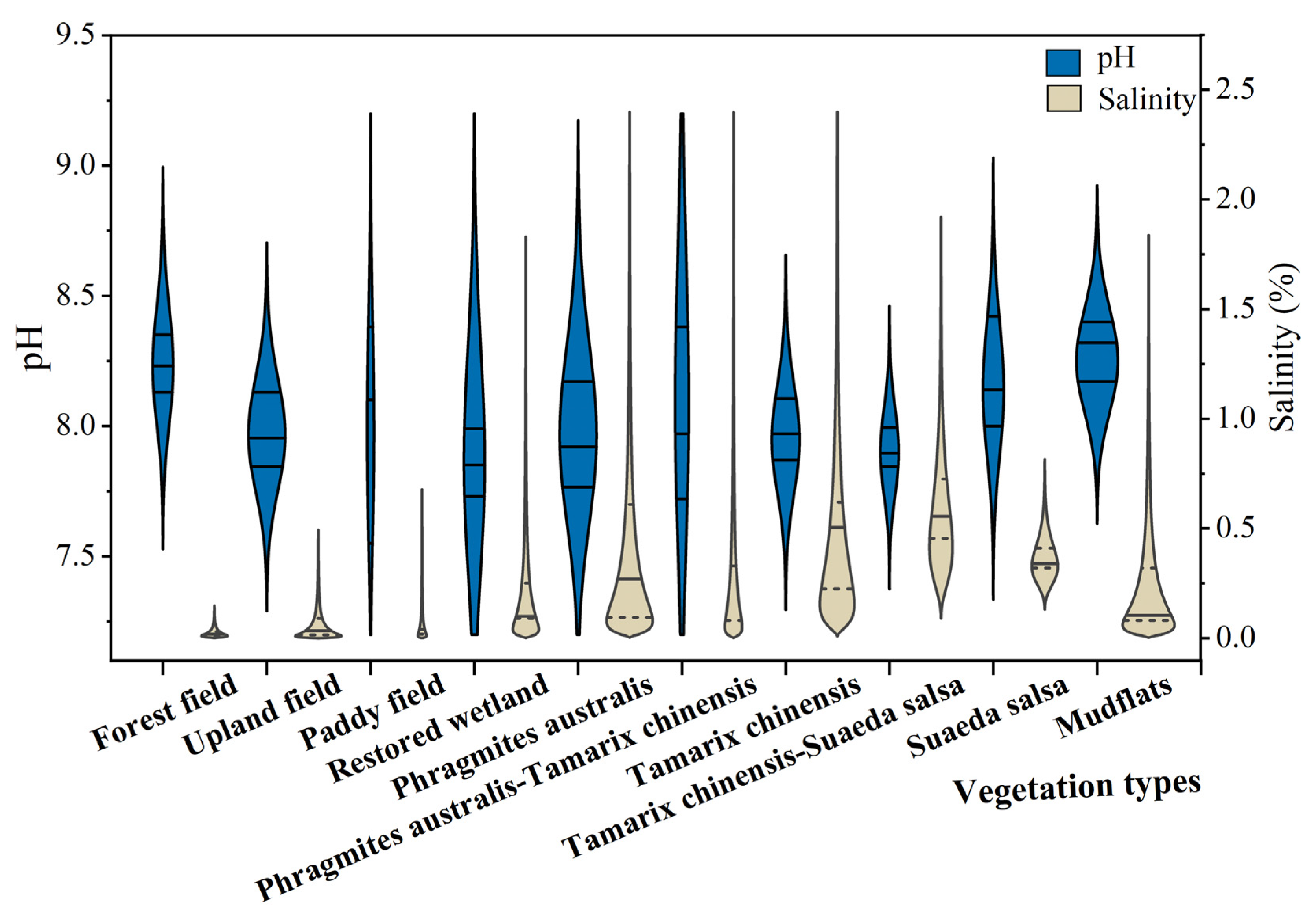

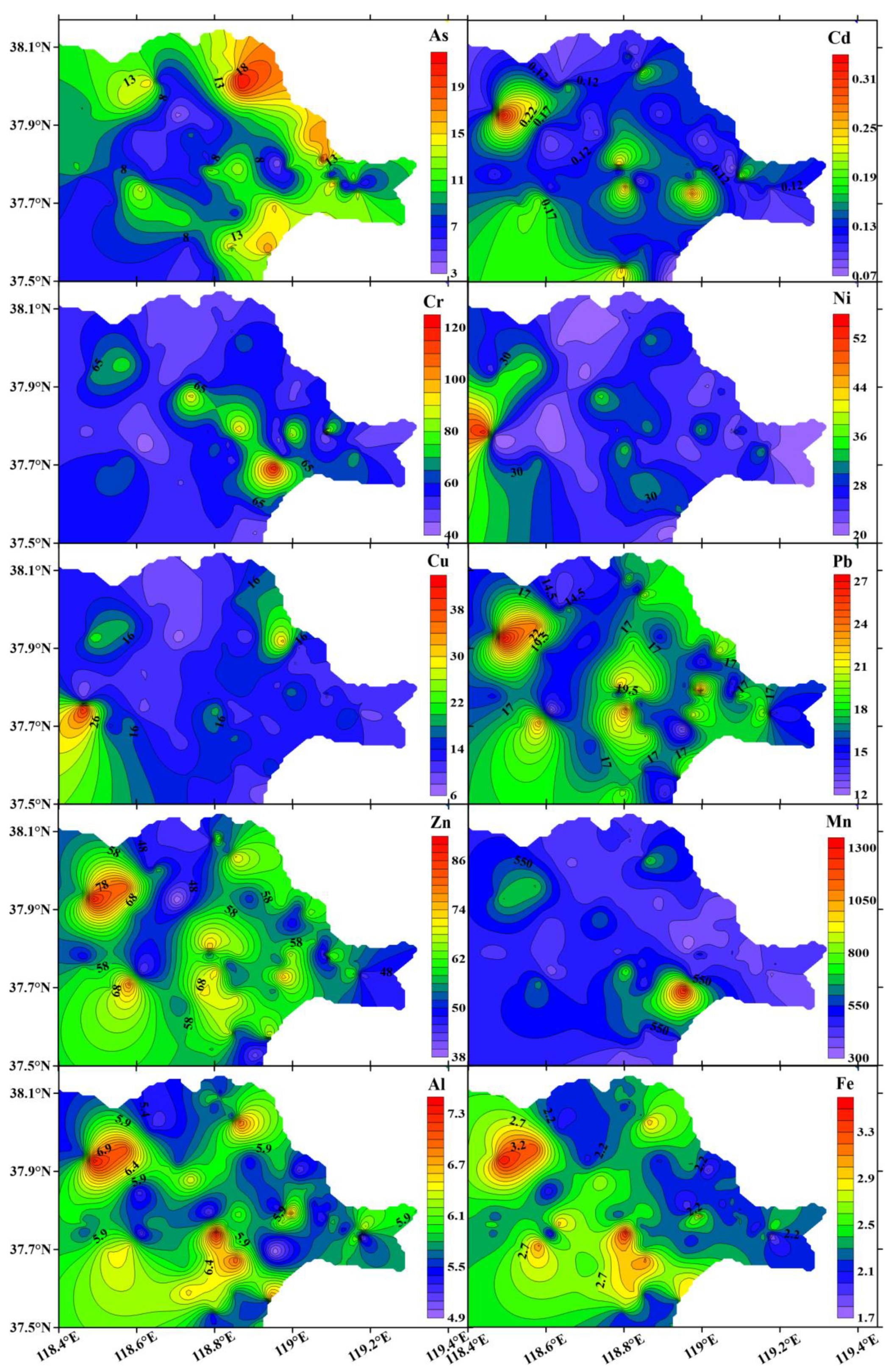

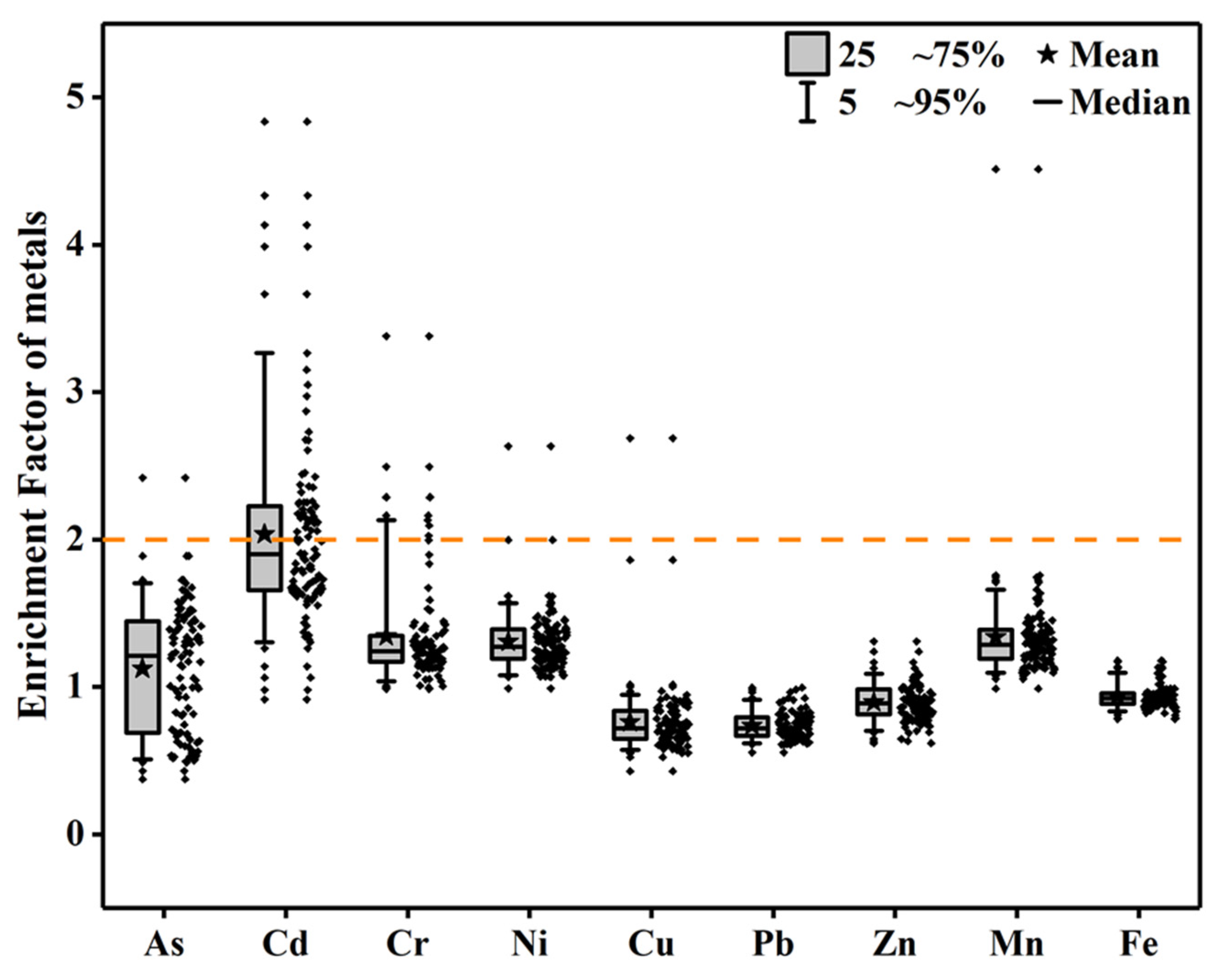
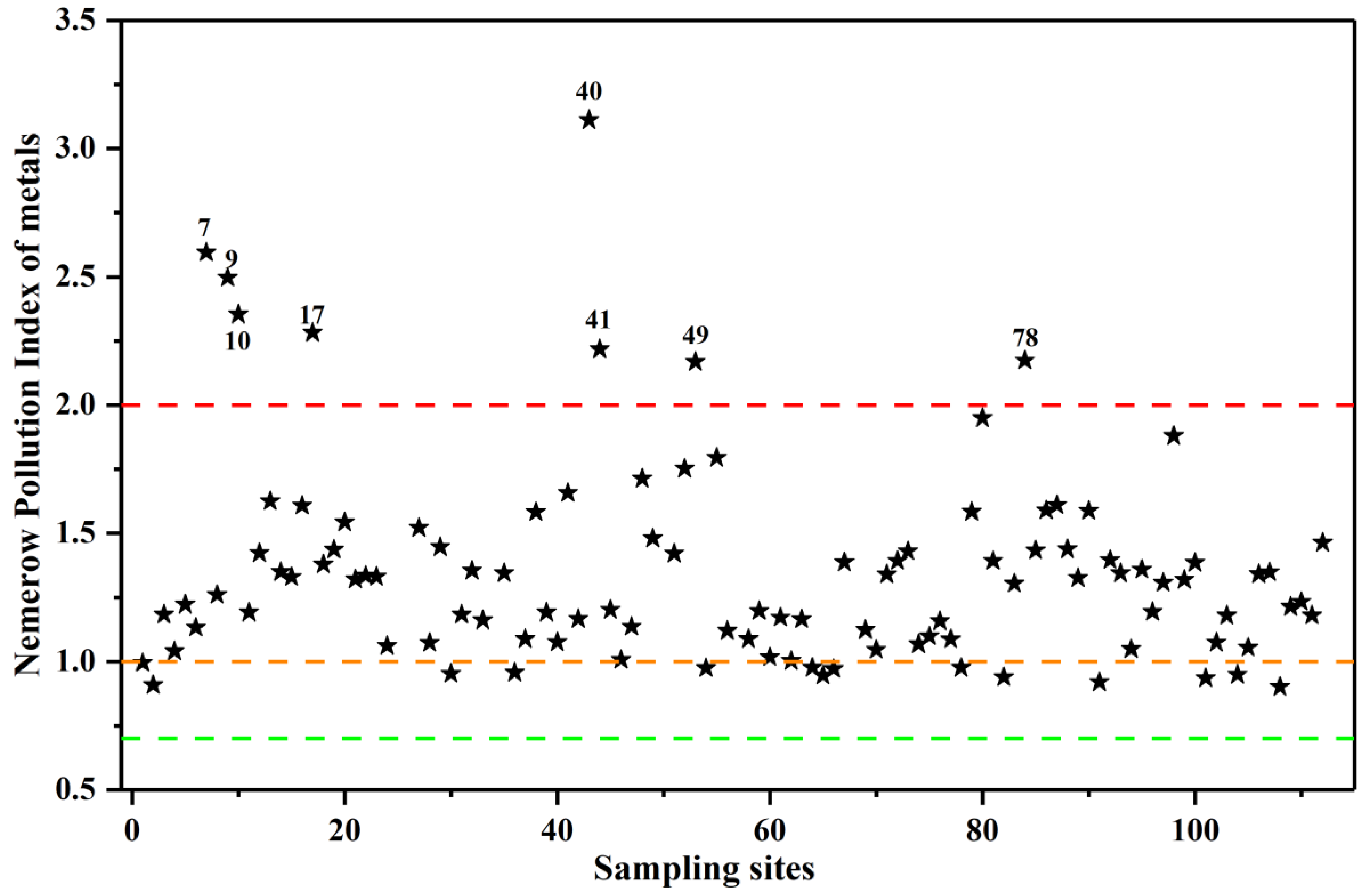
| Min | Max | Mean | SD | CV | Skewness | |
|---|---|---|---|---|---|---|
| pH | 7.35 | 9.17 | 8.06 | 0.31 | 0.04 | 0.34 |
| Salinity (%) | 0.01 | 2.00 | 0.32 | 0.36 | 1.13 | 1.90 |
| Clay (%) | 6.06 | 68.07 | 14.45 | 7.86 | 0.54 | 3.77 |
| Silt (%) | 29.93 | 84.75 | 76.18 | 7.55 | 0.10 | −3.06 |
| Sand (%) | 1.66 | 41.40 | 9.31 | 5.98 | 0.64 | 2.43 |
| Min | Max | Mean | SD | CV | Skewness | BD | BY | TEL | PEL | |
|---|---|---|---|---|---|---|---|---|---|---|
| As (mg/kg) | 3.44 | 21.89 | 10.91 | 4.03 | 0.37 | 0.19 | 9.3 | 12.4 | 7.24 | 41.6 |
| Cd (mg/kg) | 0.05 | 0.33 | 0.13 | 0.05 | 0.35 | 1.88 | 0.084 | 0.08 | 0.68 | 4.21 |
| Cr (mg/kg) | 42.47 | 123.61 | 58.55 | 14.84 | 0.25 | 2.15 | 66 | 55.5 | 52.3 | 160.4 |
| Ni (mg/kg) | 17.83 | 54.12 | 26.11 | 4.85 | 0.19 | 2.09 | 25.8 | 25.3 | 15.8 | 42.8 |
| Cu (mg/kg) | 6.82 | 43.08 | 12.89 | 4.47 | 0.35 | 3.85 | 24 | 21.4 | 18.7 | 108.2 |
| Pb (mg/kg) | 12.29 | 27.32 | 17.04 | 2.68 | 0.16 | 1.26 | 25.8 | 29.4 | 30.2 | 112.2 |
| Zn (mg/kg) | 37.20 | 89.69 | 55.97 | 9.72 | 0.17 | 0.82 | 63.5 | 79.2 | 124 | 271 |
| Mn (mg/kg) | 312.87 | 1326.22 | 471.01 | 121.62 | 0.26 | 3.79 | 644 | 446 | - | - |
| Al (%) | 4.73 | 7.43 | 5.83 | 0.55 | 0.10 | 0.66 | 6.62 | 7.38 | - | - |
| Fe (%) | 1.63 | 3.55 | 2.38 | 0.35 | 0.15 | 1.15 | 2.72 | 3.22 | - | - |
| pH | Salinity | Clay | Silt | Sand | As | Cd | Cr | Ni | Cu | Pb | Zn | Mn | Al | Fe | |
|---|---|---|---|---|---|---|---|---|---|---|---|---|---|---|---|
| Vegetation types | 0.17 | 0.49 ** | −0.10 | 0.18 | −0.05 | 0.42 ** | −0.39 ** | 0.02 | −0.13 | −0.11 | −0.14 | −0.31 ** | −0.12 | −0.19 * | −0.21 * |
| pH | −0.36 ** | 0.09 | −0.13 | 0.10 | −0.31 ** | −0.15 | −0.02 | −0.09 | −0.15 | −0.11 | −0.23 * | 0.07 | −0.05 | −0.07 | |
| Salinity | −0.14 | 0.27 ** | −0.18 | 0.74 ** | −0.22 * | −0.05 | −0.06 | −0.13 | −0.13 | −0.10 | −0.09 | −0.09 | −0.05 | ||
| Clay | −0.44 ** | −0.65 ** | 0.02 | 0.34 ** | 0.35 ** | 0.37 ** | 0.47 ** | 0.32 ** | 0.38 ** | 0.52 ** | 0.47 ** | 0.52 ** | |||
| Silt | −0.26 ** | 0.20 * | −0.18 | −0.04 | −0.05 | 0.01 | −0.11 | −0.01 | −0.13 | −0.15 | −0.12 | ||||
| Sand | −0.27 ** | −0.21 * | −0.38 ** | −0.40 ** | −0.54 ** | −0.27 ** | −0.44 ** | −0.52 ** | −0.48 ** | −0.53 ** | |||||
| As | −0.22 * | 0.11 | 0.07 | 0.06 | −0.08 | 0.05 | 0.11 | −0.03 | 0.01 | ||||||
| Cd | 0.28 ** | 0.44 ** | 0.58 ** | 0.68 ** | 0.74 ** | 0.28 ** | 0.33 ** | 0.40 ** | |||||||
| Cr | 0.84 ** | 0.72 ** | 0.48 ** | 0.56 ** | 0.30 ** | 0.42 ** | 0.38 ** | ||||||||
| Ni | 0.73 ** | 0.56 ** | 0.62 ** | 0.35 ** | 0.58 ** | 0.50 ** | |||||||||
| Cu | 0.74 ** | 0.84 ** | 0.47 ** | 0.60 ** | 0.64 ** | ||||||||||
| Pb | 0.83 ** | 0.26 ** | 0.49 ** | 0.49 ** | |||||||||||
| Zn | 0.41 ** | 0.49 ** | 0.57 ** | ||||||||||||
| Mn | 0.67 ** | 0.84 ** | |||||||||||||
| Al | 0.83 ** |
Publisher’s Note: MDPI stays neutral with regard to jurisdictional claims in published maps and institutional affiliations. |
© 2022 by the authors. Licensee MDPI, Basel, Switzerland. This article is an open access article distributed under the terms and conditions of the Creative Commons Attribution (CC BY) license (https://creativecommons.org/licenses/by/4.0/).
Share and Cite
Yu, Y.; Ling, Y.; Li, Y.; Lv, Z.; Du, Z.; Guan, B.; Wang, Z.; Wang, X.; Yang, J.; Yu, J. Distribution and Influencing Factors of Metals in Surface Soil from the Yellow River Delta, China. Land 2022, 11, 523. https://doi.org/10.3390/land11040523
Yu Y, Ling Y, Li Y, Lv Z, Du Z, Guan B, Wang Z, Wang X, Yang J, Yu J. Distribution and Influencing Factors of Metals in Surface Soil from the Yellow River Delta, China. Land. 2022; 11(4):523. https://doi.org/10.3390/land11040523
Chicago/Turabian StyleYu, Yang, Yue Ling, Yunzhao Li, Zhenbo Lv, Zhaohong Du, Bo Guan, Zhikang Wang, Xuehong Wang, Jisong Yang, and Junbao Yu. 2022. "Distribution and Influencing Factors of Metals in Surface Soil from the Yellow River Delta, China" Land 11, no. 4: 523. https://doi.org/10.3390/land11040523






